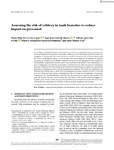Mostrar o rexistro simple do ítem
Assessing the Risk of Robbery in Bank Branches to Reduce Impact on Personnel
| dc.contributor.author | Cruz, M. Pilar de la | |
| dc.contributor.author | Cartelle Barros, Juan José | |
| dc.contributor.author | Caño, Alfredo del | |
| dc.contributor.author | Garaboa Fernández, María Concepción | |
| dc.contributor.author | Blanco Leis, Jesús | |
| dc.date.accessioned | 2022-04-25T07:31:31Z | |
| dc.date.available | 2022-04-25T07:31:31Z | |
| dc.date.issued | 2022 | |
| dc.identifier.citation | de la Cruz López, M.P., Cartelle Barros, J.J., del Caño Gochi, A., Garaboa Fernández, M.C. and Blanco Leis, J. (2022), Assessing the risk of robbery in bank branches to reduce impact on personnel. Risk Analysis, 42: 385-405. https://doi.org/10.1111/risa.13761 | es_ES |
| dc.identifier.issn | 1539-6924 | |
| dc.identifier.uri | http://hdl.handle.net/2183/30528 | |
| dc.description | Financiado para publicación en acceso aberto: Universidade da Coruña/CISUG | es_ES |
| dc.description.abstract | [Abstract] According to existing literature, bank robberies can have a considerable impact on the people involved (employees, customers, and police officers), even if the direct economic losses are negligible. Consequently, this article presents a model to assess the risk of bank robbery, with the aim of reducing the impact on the people and prioritizing the investments in security measures. It is based on the MIVES (Spanish acronym for the Integrated Value Model for Sustainability Assessment) method and it was combined with Monte Carlo simulation as a way of taking into account the uncertainty. Correlations were also modeled, for simulation purposes. Indicators for addressing issues related to security features, employees, operational procedures, and physical and social environment were defined. The model was applied to two fictitious but realistic sets of cases. The first simulation provides a quick overview of the risk level of a fictitious bank, before collecting the full set of data from hundreds or thousands of branches. The second simulation analyzes the risk variation of a specific bank branch over time. The model was also used to assess the risk index of 636 real branches belonging to a Spanish bank. All the results are presented and discussed in depth. The model allows the user to identify the weak points of a branch, so that corrective measures can be taken. | es_ES |
| dc.description.sponsorship | The present research work was supported and funded by ABANCA Corporación Bancaria S.A. Funding for open access charge: Universidade da Coruña/CISUG | |
| dc.language.iso | eng | es_ES |
| dc.publisher | Wiley | es_ES |
| dc.relation.uri | https://doi.org/10.1111/risa.13761 | es_ES |
| dc.rights | Attribution-NonCommercial-NoDerivatives 4.0 International (CC BY-NC-ND 4.0) | es_ES |
| dc.rights.uri | https://creativecommons.org/licenses/by-nc-nd/4.0/ | * |
| dc.subject | Commercial bank branches | es_ES |
| dc.subject | MCDM method | es_ES |
| dc.subject | Monte Carlo | es_ES |
| dc.subject | Risk analysis | es_ES |
| dc.subject | Rrobbery risk | es_ES |
| dc.title | Assessing the Risk of Robbery in Bank Branches to Reduce Impact on Personnel | es_ES |
| dc.type | info:eu-repo/semantics/article | es_ES |
| dc.rights.access | info:eu-repo/semantics/openAccess | es_ES |
| UDC.journalTitle | Risk Analysis | es_ES |
| UDC.volume | 42 | es_ES |
| UDC.issue | 2 | es_ES |
| UDC.startPage | 385 | es_ES |
| UDC.endPage | 405 | es_ES |
| dc.identifier.doi | 10.1111/risa.13761 |
Ficheiros no ítem
Este ítem aparece na(s) seguinte(s) colección(s)
-
GI-GRIDP - Artigos [12]






